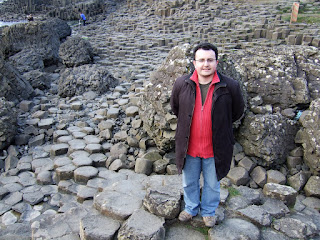




Scientific facts - The causeway was formed during the early Tertiary period some 62 - 65 million years ago over a long period of igneous activity. Three lava outflows occurred known as the Lower, Middle and Upper Basaltic. Lulls occurred between the outflows as is evident in the deep inter-basaltic layer of reddish brown 'lithomarge' which is rich in clay, iron and aluminium oxides from weathering of the underlying basalt. The causeway area would have been situated in an equatorial region at that time, experiencing hot and humid conditions. This came about due to the fact that the earth's crust is floating on moving plates known as 'tectonic plates', these move slowly but over millions of years they can travel thousands of miles. The hexagonal columns of the causeway occur in the middle basalt layer, the same formations can be seen at Staffa in Scotland (Fingal's Cave) and they also occurs in the the surrounding landscape of North Antrim and in fact many other parts of the world.
The fascinating pattern that we see in the causeway stones formed as a result of rock crystallization under conditions of accelerated cooling, this usually occurs when molten lava comes into immediate contact with water, as happens today in Hawaii, the resulting fast accelerated cooling process causes cracking and results in what we see today at the causeway. For more information on volcanism please follow the link to the right where you will find references volcanic activities and their outcomes including 'column jointing' as occurs at the causeway

1 comment:
Not very nice to take such a picture of Hakan! He looks really short legged on this one!
Post a Comment